The Line of Bottom
Monday 30th May 2016. I enjoy the new BBC film of A Midsummer Night’s Dream, as adapted by Russell T Davies. Maxine Peake is Titania, Matt Lucas is Bottom. Both are perfectly cast. Ms Peake already has that angular face one finds in Victorian paintings of fairies, while Mr Lucas brings cuddliness to the pompous Bottom even before he acquires the ass’s head (and then he really is cuddly, like a giant soft toy).Â
It’s made with the same team as Mr Davies’s Doctor Who productions, the ones with Christopher Eccleston and David Tennant. I’d say it’s especially like the Davies mini-series just before that: the David Tennant Casanova. It’s that same feeling of a fizzy, dressed-up world operating on a line of tension, with a progressive approach at one end – deliberate anachronisms, multi-ethnic casting, gay characters – and an embracing of popular entertainment at the other. This latest take on Shakespeare went out at 8.30pm on BBC1, so it had to appeal to as many people as possible. Yet it still had Davies’s personal vision at its heart: a world where fascist flags are ripped up into party decorations, where love comes in all shapes and sizes, and everyone dances to Bernard Cribbins singing ‘It Was A Lover And His Lass’. Can’t argue with that.
For all the liberties taken with the story – such as Theseus as a fascist dictator with an iPad – it’s difficult to say it’s any more radical than an average modern stage production. Since I visited the British Library’s Shakespeare exhibition, I’ve been reading about the Peter Brook 1970 RSC Dream, with its minimalist white squash court, stilts and trapezes. Birkbeck Library has two books about that production alone: a detailed making-of account by David Selbourne, and an RSC script with all the stage directions, where one can study Brook’s decisions line-by-line. His Bottom, for instance, merely gains a red nose when transformed by Puck. If a modern production has Bottom with ass’s ears, as in the BBC one, it’s still more traditional than Brook.
In the press there was a slight fuss about the BBC Titania kissing Hippolyta. This is nothing new. I read that the current Globe production of Midsummer Night’s Dream has Helena as a gay man called Helenus, with Demetrius as his lover in denial. The Globe’s previous Dream three years ago had Puck and Oberon passionately kissing. That particular Puck was played by Matthew Tennyson, a very pretty young man who happens to be a descendent of the Tennyson. He now pops up in the BBC film as Lysander, with a pair of glasses that rather makes him resemble Harry Potter. I read that as a deliberate nod to the way Shakespeare has direct links to popular culture now. If it uses the English language, it’s connected to Shakespeare.
I’ve also just remembered that there’s a lesbian bar on the Charing Cross Road, called Titania.
***
I’m going through my untidy piles of old papers, with a rule of throwing out five things every day. Discarding the ephemeral is easier when you realise it gives more value to the things you keep. And yet I do like the physical evidence of a life; the proof that whatever I’ve done, I’ve lived.
Today, with my head full of thoughts of A Midsummer’s Night’s Dream, I find a couple of letters from Dad that reference that very play.
They’re written on the backs of his own photocopied cartoons. One has a tiny Puck flying around the shoulders of two American comic book superheroes. Or rather, two versions of the same superhero, The Flash. One is the 1940s Golden Age Flash, with the winged hat; the other is the later Silver Age incarnation, with the one-piece costume and the mask.
Puck is saying: ‘I will put a girdle around the Earth in forty minutes‘. The two Flashes reply, ‘Been there, done that!’
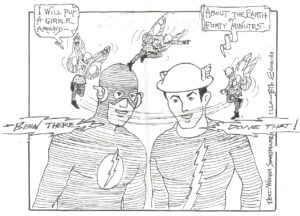
Dad’s other cartoon has a tiny Titania offering a rose to Mr Spock from Star Trek. Says Titania: ‘Come sit thee down upon this flowery bed / While I thy amiable cheeks do coy / And stick musk roses in thy sleek, smooth head / And kiss thy fair large ears, my gentle joy.’
Mr Spock, who of course has ‘fair large ears’, replies, ‘Fascinating!’.
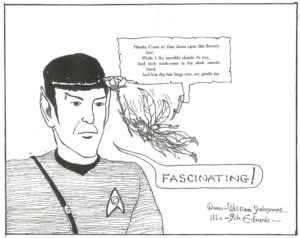
***
Friday 3rd June 2016. I find a Dutch newspaper supplement from late 2007, where I’m the cover star. Well, that’s if the cover of a supplement counts as a cover. It’s for an article on Modern Dandies of London (I think). Me alongside Sebastian Horsley, with his two fingers up to the camera. I still live in the same room, albeit with different curtains.
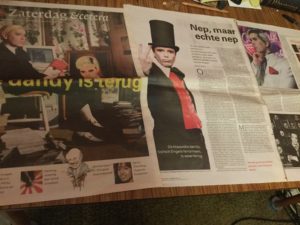
***
More mopping-up of unpublished activity.
Friday 6th May: While people have stopped me in the street to ask me why I hadn’t written more about the death of Prince, no one has yet chided me for my complete omission of the London mayoral election. Perhaps that sums up what sort of diarist I am.
Still, it needs to be said that I did indeed vote. Voters had a second preference, so I gave my first choice to the Greens’ Sian Berry, and my second to Labour’s Sadiq Khan. Khan triumphed, his victory announced late into the night of the 6th (after an agonising delay of many hours). Ms Berry came in at an impressive third, after the Conservatives’ Zac Goldsmith. She also took up a seat on the London Assembly, thanks to the Greens doing well enough on the ‘London-wide’ polling sheets.
It’s the first election result in years where I’ve felt optimistic about the future.
***
Films seen recently:
Tuesday 17th May 2016: Green Room at the ICA. £3. A horror thriller with the unusual backdrop of a right-wing skinhead music scene, in contemporary rural Oregon. Rather different to the Portland liberals of that same state, as spoofed in Portlandia. But then I suppose it’s analogous to the way parts of Sussex can be rather less progressive than Brighton.
Imogen Poots’s character has one of those skinhead-scene girls’ haircuts that flatter while adding a certain toughness: long at the sides with a sharp fringe at the front (a Chelsea Fringe? a Feathercut? not sure). The boots and braces look for the men is well-researched too – straight out of 1970s Britain, but jostling here alongside iPhones and American accents. Much significance given to the colour of laces in DMs. A couple of the scenes are extremely gory. But then it is meant to be a horror film too. I suppose boxes must be ticked in plot, in the same way that the characters must tick boxes with their clothes, their taste in rock music, and with their beliefs. These days, I find discussions about belonging thrilling enough; blood and violence less so.
Friday 20th May 2016: Heart of a Dog at the ICA. £3. Laurie Anderson’s stunning film essay, ostensibly about the death of her rat terrier Lolabelle, but touching on life and death in all kinds of ways, from the passing of friends and relatives, to the changes in New York after 9/11. Her husband Lou Reed’s death (which happened during the making of the film) isn’t explicitly referred to, but he’s there briefly as an actor (playing a doctor), and as himself (in footage of the couple on a beach). He also provides the closing song, and in the very last shot he is seen holding the dog.
At one point Anderson talks about that unhappy experience that most pet owners must endure: going to the vet to hear what she calls ‘The Speech’. The one that asks the owner if the pet can be put to sleep. It reminded me how I was recently told, separately, of the deaths of two cats I used to look after in North London: Claudia Andrei’s cat Sevig, and Jenn Connor’s Vyvian. When Sevig became very frail, Claudia pushed him around the streets of Edinburgh in a shopping trolley – ‘the Sevig-mobile’. After seeing Heart of a Dog I realised how lucky I was to have the pleasure of living with these beautiful creatures, without ever having to face The Speech.
Tuesday 24th May 2016: Troublemakers: The Story of Land Art, ICA. £3. A documentary on a group of artists in the late 60s and early 70s, who turned vast, desolate parts of the US into their own canvasses in the pure pursuit of Making Art. I was familiar with the Lightning Field artwork – all those lightning rods against the sky- but I hadn’t heard about works like Double Negative, where two gigantic rectangular chunks were carved out of a rocky mesa. According to the credits, some of the works begun in the 1970s are still in progress today.
Thursday 26th May 2016: Love and Friendship at the BFI. Free, courtesy of Tim Chipping, a fellow Whit Stillman fan (we went to see Barcelona together on its 1990s release). The film is followed by a Q&A with Whit Stillman, who is in typically eloquent and wry form. The film adapts Jane Austen’s Lady Susan, though there are touches of Wilde in Stillman’s script too. It’s verbose without ever being dry, and in terms of quips and jokes, it’s funnier than most modern comedies. My favourite film this year.
Friday 3rd June 2016: The Witch at the Prince Charles. £4. A tale of supernatural goings-on amongst a family of Puritan settlers, in seventeenth-century New England. Like Green Room, it blends the horror genre with more unusual aspects, in this case, gritty historical drama. The dialogue is lifted straight from the literature of the time: all ‘thy’s and ‘thee’s. As with Whit Stillman, the style only works once you realise what the director is trying to do: in this case, make a film that takes folk legends as real without question. It’s as if the film was made by seventeenth-century Puritans, as well as being about them.
***
A useful acronym from Atalanta K, who lost her bag after a night of carousing: ‘I had a CRAFT moment. As in: Can’t Remember A F-ing Thing.’
Tags:
a midsummer's night dream,
bbc,
Claudia Andrei,
dad,
dandies,
Dandyism,
films,
green room,
heart of a dog,
ICA,
jenn connor,
laurie anderson,
love and friendship,
Prince charles cinema,
Sebastian Horsley,
sevig,
shakespeare,
the witch,
vyvian,
whit stillman
Diamonds and Beaus
Friday 13th May 2016. Early afternoon: I’m recognised in Jermyn Street by a gentleman who says he enjoys this diary. In fact, he crosses the street to tell me this, narrowly avoiding being run down. Surely no writer can ask for higher praise than this: a reader risking their own life to pass on a good review. Perhaps it should go on the back of a book. ‘I enjoyed Dickon Edwards so much, I was nearly hospitalised’.
He adds that he was disappointed I didn’t say more about the death of Prince, given what I’d said about Bowie a few months earlier. This is a perfectly good point.
I think one reason might be that, when I was growing up, I’d always regarded Prince as one of my brother Tom’s favourites; his territory more than mine. For some reason we divided up singers and bands between us, as if they were soft toy animals. I got to cuddle New Order, the Pixies and the Smiths, Tom had the Cult, the Beastie Boys, and Prince.
But if one loves good pop songs, and believes, as I do, that pop music is at its best when used as a platform for individuality, eccentricity, and indeed dandyism, obviously one has to admire Prince.
It’s all the more apt that this request took place on Jermyn Street. The street is something of a dandy Mecca, being home to some of London’s most stylish menswear shops, to the church of St James’s Piccadilly, where Sebastian Horsley had his funeral in a red squinned coffin, and to a statue to that most influential of London dandies, Beau Brummel. It is a statue close enough to the ground to be hugged, an act which dandyish American friends of mine make a point of doing whenever they visit.
A further coincidence is that I was on my way to the London Library, a block away in St James’s Square. After parting company with the reader, I remember that I’d once found a book on dandyism in the library, one which directly compared Prince with Beau Brummell. So today I go straight into the stacks and retrieve the book in question.
The book is called Rising Star: Dandyism, Gender and Performance in the Fin de Siècle, by Rhonda K. Garelick (Princeton, NJ: Princeton University Press, 1998). As part of a chapter on the legacy of dandyism, Garelick reprints a 1995 Esquire cover, on which Prince pulls a definite dandyish pose. It’s from his Artist Formerly Known As phase, just after his hit, ‘The Most Beautiful Girl In The World’. His hair at this point is short, dark, combed and straightened, with a touch of the silkily feminine (even a Hugh Grant-ish schoolboy floppiness). He has a thin pencil beard that seems an extension of his cheekbones, and wears a slim pinstripe suit, buttoned down, over a white shirt with big cuffs. He sports a dark tie (collar button undone), fingers covered in rings, and leans against a silver cane.
According to Garelick, Prince’s image at this point follows in the classic nineteenth-century dandy traits. Prince ‘borrows unmistakably from the likes of Beau Brummell, Baudelaire and Jean Lorrain’. The main criteria are his aloofness, his air of contempt for convention, and his highly stylized persona. On top of that, his 1990s adoption of an unpronounceable symbol allies him with Barbey d’Aurevilly’s idea of the dandy life: one of pure surface and symbol, an influence beyond language: the dandy is ‘that which can hardly be recounted’. Certainly, changing one’s name to an actual symbol takes that aspect of dandyism to the limit. Though I’d say Prince had already put his stamp on language by that point, given his love of turning words into single letters or numbers, as in ‘I Would Die 4 U’.
The gendered aspects of Prince’s dandyism were equally fascinating. Granted, it may not have been original for a male, black, American performer to play with femininity in the rock and pop field; one thinks of Little Richard and Rick James. But Prince used his influences in order to do as Bowie did: make something new. He especially intensified the androgynous aspects of his imagery, imbuing them with that most deviant of colours – purple.
I think of that campest of pre-war dandy writers, Ronald Firbank, and his love of writing with purple ink. I also think of Brigid Brophy taking this detail of Firbank’s so much to heart, she apparently switched to using purple ink for the longhand manuscript of Prancing Novelist, her 1973 study of Firbank. The Brophy book is 600 pages long. That’s a lot of purple.
Through these deviant codes, Prince’s dandyism became an outrageous queering of heterosexuality – a machismo-troubling version of Camp Rock which he shared with such figures as Marc Bolan, Tiny Tim and Russell Brand (who isn’t even a musician, but he hasn’t let that stop him).
Garelick’s book also compares Prince’s use of female dancers and co-singers with names as Vanity, Apollonia, and Mayte, as echoing 1890s Decadent ‘tableaux’, such as ‘Aubrey Beardsley’s Salome drawings of androgynous, erotic, and nearly twin creatures’. Though in Prince’s case, says Garelick, the women were not so much twins as shadows in his wake, a ‘merging of the dandy and the danseuse‘.
Certainly, any woman appearing with Prince had to become remade in his image. I never saw Prince in concert, but I was interested enough to catch his 1987 concert film Sign o’ the Times, when it hit British cinemas. For the song ‘U Got The Look’, the female role was filled by the Scottish singer Sheena Easton, who’d already had a successful career in her own right. For ‘U Got The Look’, though, she became well and truly Prince-i-fied. From her singing to her clothes to her poses, she was not so much a guest vocalist as just another interchangeable cog in the man’s machine. When in Purple Rome, you do as the Purple Roman does.
More recently, I thought of Prince when I heard the song ‘Quicksand’ by La Roux, aka Elly Jackson, a young singer who might herself be described as a dandy (the National Portrait Gallery’s shop currently has her on a postcard, wearing a very Bowie-esque mustard yellow suit). Musically, ‘Quicksand’ is clearly influenced by ‘When Doves Cry’, from the chords to the clipped 80s synths. But Ms Jackson’s singing is a very Prince-like style too: shifting across the genders from high feminine falsetto to low, growing boyish swagger. For me, that’s when art is at its best: when there’s a breaking out of prescribed roles, and the same trappings of said roles are re-used on the artist’s own terms, to communicate their individualism. And that’s also a definition of dandyism, in my book.
***
Evening: to the ICA to see Mustang, a Turkish film, set in the present day, about five teenage orphan sisters living in what seems like an idyllic picturesque setting: a hillside village near the Black Sea coast. Their mildly rebellious behaviour during the school holidays, however, sees them dramatically punished by their guardians – first with imprisonment in their own home, complete with bars on the windows, and then into forced marriage to equally reluctant young men. The film’s sensualised, slightly surreal atmosphere accentuates the idea of a close-knit group of girls disappearing into a world of their own, thus placing the film in the same tradition as Picnic at Hanging Rock, The Virgin Suicides, and last year’s The Falling.
With the added dimension of the conservative Turkish setting, though, Mustang has more complex questions about the role of arranged marriage in a changing world. The girls’ captor, their grandmother, is no fairy tale tyrant; she merely believes that, because she herself was married off straight after puberty, that’s the way it should be. Indeed, for one of the sisters, her marriage to the boy she was already seeing is shown as a good thing, if a hasty one. For the others, though, freedom comes in the form of escape to the big city – Istanbul – and to the parent they really want: a beloved schoolteacher. The real asset of the film, though, is the utterly naturalistic and convincing performances, particularly by the youngest sister.
Tags:
brigid brophy,
Dandyism,
ICA,
jermyn street,
la roux,
Mustang,
Prince,
ronald firbank,
The London Library
Among The Dandies
Tuesday 17th September. To the tailors Gieves & Hawkes in Savile Row for a book launch. The book is I Am Dandy: The Return of the Elegant Gentleman, or as certain friends of mine would describe it, The Big Book Of Hot Men.
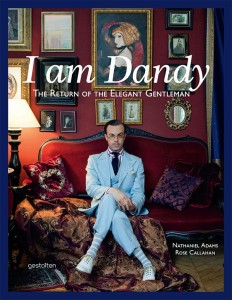
It’s a large and lavish hardback comprising profiles of about sixty gentlemen who dress in an individual and elegant way. The book combines full colour photographs by Rose Callahan with text by Nathaniel ‘Natty’ Adams, based on his interviews with the dandies. It is the sort of volume that was once called a coffee table book. I suppose now it is better described as a latte plinth offline HD tablet.
Given the event is about dandyism, I decide to don Sebastian Horsley’s old suit once again, the silver velvet John Pearse 3-piece, now altered to fit me a bit better. Keen to represent my own style as much as the late Mr Horsley’s, I leave out his wing-collared Turnbull & Asser shirt in favour of one of my own cheap small-collared supermarket shirts, and add my simple white pocket square handkerchief, seahorse brooch and cufflinks, along with my battered Gucci loafers. Belatedly I forgot I own a Cad & The Dandy tailored shirt of my own – never mind.
Some years ago a similar photography book on modern dandies came out. It included the Dexys singer Kevin Rowland and Sebastian Horsley. I remember (shamefully) whining to Mr Horsley that I wasn’t included. ‘Oh, you’ll be in the next one,’ he said. He was quite right. So that’s another reason to wear his suit to the launch. A Double Dandy representation.
It’s a rainy evening. A doorman tips his top hat to me as I enter. The shop is an unexpectedly large and high-ceilinged space, with a balcony floor that functions as a museum of Gieves & Hawkes’s history. Glass cases display military tunics, centuries old. Among the many suits on rails and manniquins, hat boxes, chests of drawers and cutting tables there is a jazz band playing, while at the other end of the shop a stage has been set up to make announcements. It has a screen as a backdrop which projects a selection of photos from the book. Waiters offer free champagne, then hover around and refill your glass when it runs low. After the champagne runs out, I move onto lychee martinis. One of the great things about book events is that they’re over by 8pm, so one can get drunk and be in bed by ten, to make an early start on recovering. Book launches lend themselves to efficient hangover management.
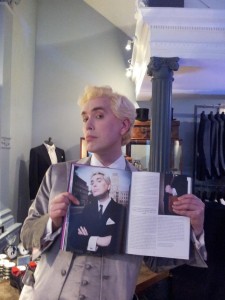
[pic by Suzi Livingstone]
I say hello to people I know: Suzi L, Minna M, Rose and Natty, and chat with some of the other dandies in the book who are at the event: Robin Dutt, Ray Frensham, Tony Sylvester (the gentleman from the Quietus article), Barima Nyantekyi, Michael ‘Atters’ Attree, Gustav Temple. There’s also the teenage dandy Zack MacLeod Pinsent. It will be interesting to see if young Mr P keeps up his look into his twenties and thirties; many people his age are still working out who they are.
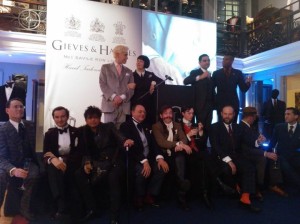
[pic by Kira of Scarlet Fever Footwear.]
The photographer Kahlil Musa has a portrait studio set up in the changing room area. Here’s the shots he took of me on the night.
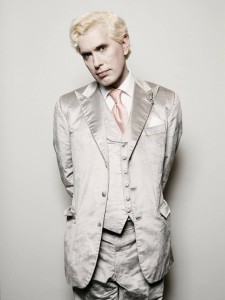
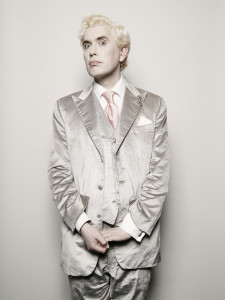
[Pics by Kahlil Musa, taken from the Gieves & Hawkes Facebook and Pinterest pages]
Given that dandies are like cats: essentially aloof, wary and self-contained (at least, that’s one way I define dandyism), it’s quite a coup to gather so many of them in the same room, let alone get them to agree to be in the same book. There are also inevitably going to be opinions over who should have been in the book but wasn’t, and who was included but isn’t a ‘proper’ dandy. But at this event no fights break out, and everyone seems friendly and fun. Mr Atters is particularly entertaining; I’m impressed by his choice of lapel brooch: a small stuffed bat.
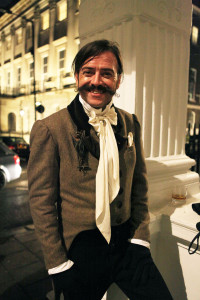
[pic by Kelly René Miller from the Stylesight blog]
Along with the other dandies present, I sign a couple of copies of the book for Rose & Natty, for their own collection. Specifically, I sign the photo of me in a chalk white suit – the whiteness lending itself to the purpose.
It’s a shame the American dandies in the book couldn’t be there, as it’d be nice to see the ones I’m acquainted with such as Fyodor Pavlov (whose wedding I attended) and Cator Sparks (who showed me round New York). I’d also like to meet Lord Breaulove Swells Whimsy and, most of all, Gay Talese. At 81 years of age, Mr Talese has maintained an almost OCD approach to dandyism: one of Ms Callahan’s most striking photos shows his wall of hats, all carefully wrapped in clear dust covers and labelled underneath like hunting trophies. Which in a way is what they are. He’s also the only dandy in the book to have his own words published as a Penguin Modern Classic.
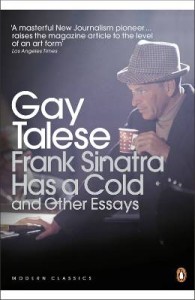
I keep meeting British book lovers who haven’t heard of Gay Talese (pronounced ‘Ta-leez’), or his classic magazine article ‘Frank Sinatra Has A Cold’. I suspect this is because, unlike his New Journalism colleagues Tom Wolfe, Hunter S Thompson, and Truman Capote, he never wrote actual fiction, not even heavily autobiographical fiction.
The New Journalism gang believed – though perhaps not officially – that writers should put an effort into styling their appearance as well as their prose. Gay Talese is definitely a dandy. Wolfe has his white suits; Capote and Thompson each maintained a strong look. Whenever I’m in a bookshop and have to choose between two equally attractive books (in terms of content), I have to find a reason to choose one over another. So I look at the author photo and judge them by the choice of clothes they make. Double denim novelists, be warned.
Links with more photos & info on the I Am Dandy event:
Book ordering details from the publisher, Gestalten
Gieves & Hawkes blog
Rose Callahan’s Dandy Portraits blog
Stylesight
Mode Parade
Dandyism.net
Gay Talese’s 1966 article ‘Frank Sinatra Has A Cold’ can be read for free at the Esquire website. But the more stylish option is to buy the Penguin Modern Classics edition. And be seen reading it in public.
* * *
Friday 20th September. Â Rushing to cross the road, I manage to pull a muscle in my back, and walking for the next two days becomes painful. I seem to be prone to such injuries, having consigned myself to a weekend of limping a month or so ago after doing something similar to my ankle.
In my case, the degree of overexertion is risible; it is not caused by any manly overdoing it on the rugby field or in the gym, but just by a sudden everyday movement after a period of staying still. The ankle pain was the result of waking up one morning, realising I was late for a train, then putting my foot out onto the floor too quickly. That was enough. An anxious and tense thing by nature, I am not built for making sudden movements full stop, even for flight rather than fight. I would make the world’s worst spider.
Saturday 21st September. To the Adam Street club off The Strand, to DJ for the Last Tuesday Society once again. Before I start there is a talk on the I Am Dandy book by Rose Callahan and Natty Adams. I ask them if they found some crucial difference between American and European dandies.
‘Firstly,’ says Mr Adams, ‘it’s only ever Europeans who ask that question about Americans being different. If there is a difference it’s that American dandies tend to look to the 1920s Jazz Age styles, while Europeans favour the Victorian age.’ He cites the top hat as something that Americans particularly tend to avoid.
Evidence of a post-Fifty Shades of Grey era. Although the club night is not a fetish one, in a corner of the room in which I am DJ-ing is an apparatus for being strapped to and whipped, and tonight there is a black-clad gentlemen hired to do just that. I think at first that the people being whipped are also hired by the promoters, in the spirit of providing an interesting ambience. But it transpires they are partygoers:Â it’s an option included in their ticket. Every song I play while the whipping and spanking goes on takes on immediate innuendo, though accidentally. ‘I Want To Be Happy’, ‘Get Happy’, ‘In The Mood’ and especially: ‘Blue Moon’.
Tags:
book launches,
Dandyism,
gay talese,
gieves & hawkes,
i am dandy,
natty adams,
rose callahan,
Sebastian Horsley
Sequined Vodka Tales
A Fosca London gig announcement. Oh yes!
It’s the much-threatened Fosca Farewell show. Saturday December 13th at Feeling Gloomy, Bar Academy, Islington. Stage times to come.
The line-up will a five-piece, three-guitar and two synths (plus laptop) assault: Rachel S, Kate D, Tom E, Charley S and myself.
***
Two DJ gigs of mine, at somewhat shorter notice.
I’m DJ-ing on Sat Sept 20th, at a plush dress-up event called The Magic Theatre. This takes place in an Art Deco ballroom in Bloomsbury. Here’s what their website says about the dress code:
“Ladies: The perfect place for all you Cinderellas and Style Queens, Pink Princesses and Leggy Latex Babes… Audrey Hepburns and Barbarellas, TV’s, Saucy Secretaries and Rock Chicks…Whether you’re a Goth Girl, Dowager, French Maid or Precocious Teen Queen, Marie Antoinette, or Marilyn Monroe, the Magic Theatre is YOUR stage. Gentlemen: Retro Glamour, Uniforms, Lounge Lizards, Gentlemen of the Cloth, Fauns, B-Movie Stars, Prince Charmings, Pirates and Dandies of all kinds…Arise, Sir Galahad, kneel before Zod, come out, come out you Peter Pans, Dick Turpins and Darcys…”
I’ll be doing two DJ sets between 8.30pm and 11.30pm. Ticket details at www.magic-theatre.co.uk.
***
I’m also putting in a brief DJ appearance at The Beautiful & Damned on Thursday 18th, at The Boogaloo (near Highgate Tube). Martin White & The Mystery Fax Machine Orchestra will also be playing. The B&D isn’t ‘my’ club any more, as I’m forever correcting people, but it’s still going strong under the auspices of Miss Red and The Boogaloo team. They’ve reinvented it into a kind of cabaret / club night / music hall booth affair. It’s great to see unwitting Highgate pub goers wander in off the street, and wonder just what weird, time-hopping universe they’ve stepped into. Part Red Room in ‘Twin Peaks’, part Sapphire & Steel…
***
Back to the diary.
Wednesday evening: to Trash Palace in Wardour Street, for a club night called ‘Polari’. It includes Jamie McLeod’s exhibition of modern dandies, which in turn includes me. Always nice to swan into a club to see a large framed photograph of oneself on the wall. The club also supplies free quiche.
On this occasion, special guest Sebastian Horsley takes the mic, and prowls and provokes and reads from his book, to a packed and appreciative crowd. Including his mother. He’s in his red sequined suit and brandishes a matching sequined bottle of vodka. Well, a sequined bottle cosy.
I say hello to David Benson, Anne Pigalle, Jason Atomic and Ms Ruta, and meet Clayton Littlewood, author of the ‘Soho Stories’ column in the London Paper. The window by his writing desk (or rather, laptop perch) looked out from the clothes shop he worked at, Dirty White Boy in Old Compton Street. A particularly good spot in London to watch people and gather (or imagine) stories: Soho media types, the famous, the homeless, the vicious queens, the prostitutes, the tourists, the tramps, the old survivors, the new blood. He’s put together a book version: ‘Dirty White Boy: Tales Of Soho’, which I’m rather looking foward to.
More details at his MySpace page, with excerpts, readings and so on: www.myspace.com/dwbsoho
After Polari, Mr Benson takes myself, Mr H, Mr L and his friend Ms Lois for dinner at one of the Chinese restaurants in Gerrard Street. Sebastian invites me to an orgy on Friday. I politely decline. I’ll be busy playing indiepop songs in Madrid. Many of which are about, well, not going to orgies.
Tags:
Anne Pigalle,
Beautiful & Damned,
Clayton Littlewood,
Dandyism,
David Benson,
DJ gigs,
Fosca,
Fosca gigs,
Fosca play Madrid,
Martin White,
Polari,
Sebastian Horsley















